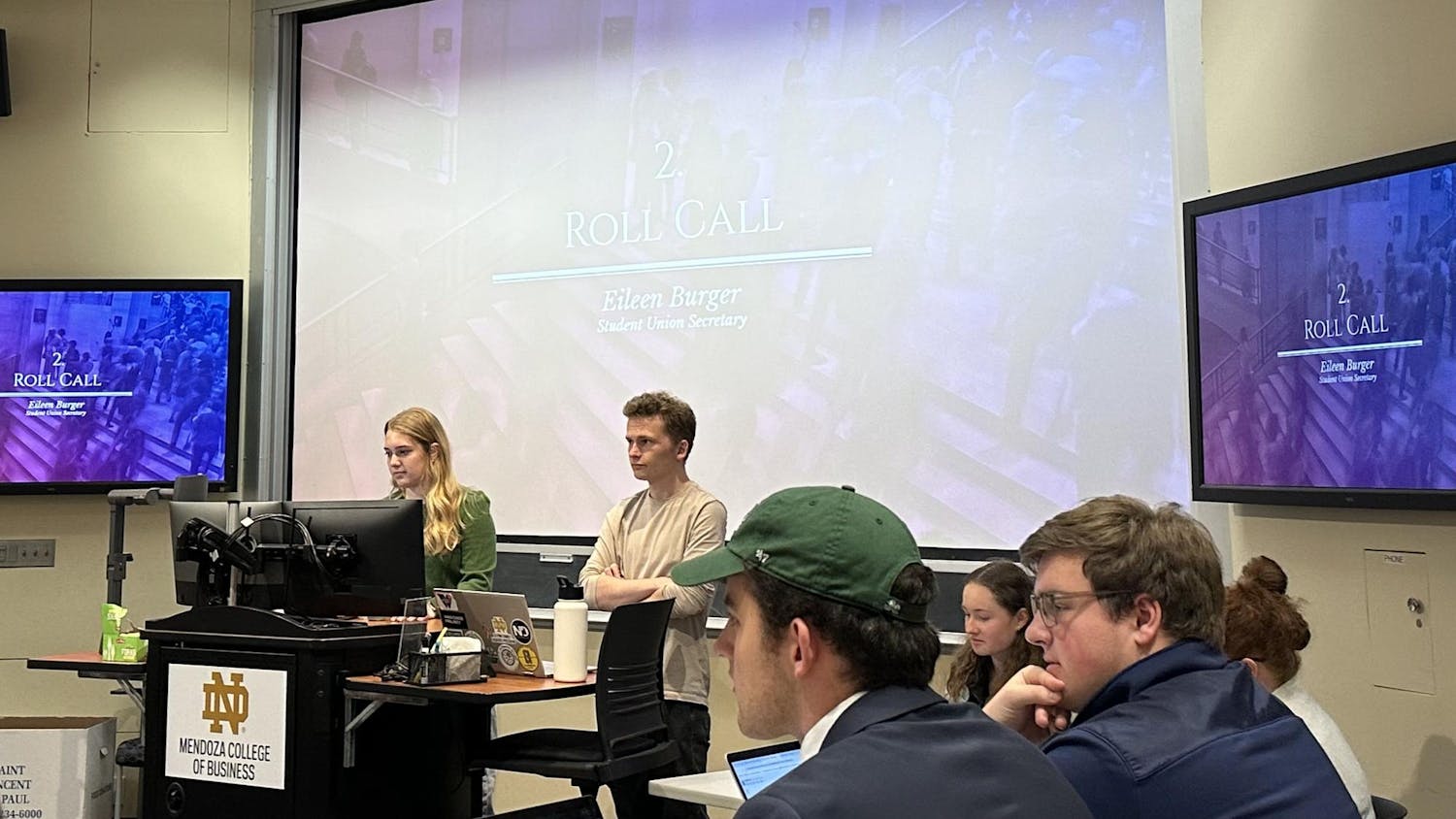Members of the Saint Mary’s community gathered for a faculty colloquium in Madeleva Hall on Friday to hear professors present their recently-completed research.
Mary Welle, associate professor of nursing science, and Reena Lamichhane Khadka, assistant professor of biology, presented their research concerning healthcare-acquired infections. Alissa Russell, assistant professor of psychology, also presented her research concerning college students’ self-regulatory skills, daily stress and negative affect.
Welle and Lamichhane Khadka began the colloquium with their presentation “Hospital-Issued Slipper Socks: An Overlooked Route of Infection Transmission?” The idea began, Welle said, when she found herself admitted into the hospital for surgery.
“I had surgery, and I was in the hospital, and I did not want to get an infection,” Welle said. “I knew I was going to have to get up and walk, because that’s very therapeutic, but I also knew I was going to have those silly slipper socks on that prevent falls.”
Welle said she worried about catching an infection from using her socks constantly.
“One of the basic lessons of nursing is if anything falls to the floor it’s considered contaminated so they throw it back in the dirty linen,” she said. “I knew the slipper socks would be touching the floor and then I would probably get back in bed with those slipper socks.”
Welle approached Lamichhane Khadka, who is experienced in doing research on healthcare acquired infections (HCAIs), infections that patients get from the hospital environment while receiving treatment for medical or surgical conditions, to help with the study. Four nursing and three biology students also aided in carrying out their research, Welle said.
Welle said a previous study showed that slipper socks do pick up pathogens from the floor, but no research had been done as to whether the pathogens are transferred from the socks to the bed, so that's what the pair focused on in its study.
The goals of the study were to find out what kinds of bacteria are present in the orthopedic wards of two midwestern hospitals, whether there any potentially pathogenic bacteria present, how resistant the bacteria are to antibiotics and to examine the spread of the pathogens from the floor to the bed via the slipper socks, Lamichhane Khadka said.
“A very high number of Staphylococcus species, which is a common gram positive bacteria species, was found,” Lamichhane-Khadka said. “Of that species, 9 percent were Aureus in Hospital 1. This includes the infamous MRSA bacterium.”
According to the CDC, MRSA is a highly contagious infection that can result in rashes, headaches, fever, chest pain and/or shortness of breath. MRSA is resistant to many antibiotics and is therefore difficult to treat.
Results from the gram negative bacterial pathogens, were more diverse in both hospitals. Gram negative bacteria are usually of intestinal origin, Lamichhane-Khadka said, but they can also cause infections in other parts of the body, potentially resulting in catheter-associated urinary tract infections and pneumonia.
The study found that citrobacter, salmonella, klebsiella and pseudomonas were gram negative bacteria found that were of particular concern.
According to Welle, these results have significant implications for healthcare facilities, workers and patients.
“Everyone wears those socks in the hospital, and most patients get up and touch the floor,” Welle said. “We have to think about the hands of those workers. We are taking those socks on and off to test neurovascular status and then proceed with care to the patient without washing hands. We need to think about lower surgical sights and incisions, which are ankle, foot and knee surgeries, that are coming in contact with the sheet from slipper socks.”
Welle said simple practice changes can make a huge difference in the spread of infections. The socks are about 60 cents per pair, so Welle said she suggests that healthcare facilities provide patients with two pairs of socks, one dedicated to the floor and one dedicated to the bed.
“It’s going to take teamwork to change,” Welle said. “Research has shown the next person in a room after an infectious patient can acquire the same infection. So, we have to think about the people who clean the rooms too.”
Russel then began her presentation about the correlation between self-regulatory skills and daily stress.
As a developmental psychologist, Russell said she focuses her studies on how people change over time. Specifically in this study, she is focussing on the interactions and variability of the global and general experience of college women compared to their daily lived experience.
“You may be unsurprised to find out college students are finding greater difficulty in regulating their emotions,” Russel said. “They are overwhelmed and anxious. Especially college women.”
Although teens at the age of 18 are legally considered to be adults, Russell said she and other theorists have argued that college students are not adults.
“College ... students are in their own stage of life called ‘emerging adulthood,’” she said. “Students move away from home without continual supervision, but college isn’t real life, it’s a period of transition.”
Russell says individuals in this stage do not meet the milestones of adulthood such as marriage, having children and monetary independence. In addition, their prefrontal cortex is not fully developed, meaning their evaluation of risks, rewards and delayed gratification is not the same of that of an adult from a neurological standpoint. The prefrontal cortex is fully developed in those who are aged in their mid 20s, she said.
“Students also do not consider themselves to be adults yet,” Russell said. “They are exploring a variety of goals, their love life and a career. They are increasingly acquiring these skills.”
Russell said self-regulation, the ability to align thoughts and actions with values, can help ease a college student’s transition to adulthood. This idea is supported by research that has demonstrated that self regulation strategies, emotion regulation and constructive thinking reduce depression, anxiety and stress the first year of college, she said.
“How you react to daily stress has a lot of implications for well being,” Russel said. “Some people react more and therefore have more negative affect. Identifying strategies that can promote a better response is important.”
Not enough work has been done to say which strategies are useful and which ones are not, she said.
Russell’s study included 90 students from Saint Mary’s College. She evaluated three ways in which the students said they self-regulated. The first is goal commitment, which means a student has the persistent mindset of ‘Where there’s a will, there’s a way.’ The second is positive reappraisal, which means a student has a positive mindset and makes an effort to look at the bright side of things. The third is lowering aspirations, which means the student reevaluates goals and possibly drops a goal that he or she considers to be unimportant.
Her study was performed in the form of a survey, she said. Students took the survey three times a day for a week long span. The survey asked students to answer how much stress they feel in the moment.
Unlike previous studies, Russell wanted to evaluate student’s variability in their answers.
“Two people can have an average of three,” she said. “However, that doesn’t describe their entire experience. One person’s answers may vary far beyond a score of three, whereas another person may consistently score a three on the survey.”
Her results show that stress was a powerful predictor of concurrent negative affect, meaning regulation strategies did not predict anything beyond that. However, the regulation strategies did predict variability, she said. Those with lowering aspirations strategies had significantly more variability than those with goal commitment strategies. She said this means those students had more perseverance and, as a result, had more stable stress levels.
Based on the marginally significant results concerning the interaction between strategies and higher or lower negative affect, Russell said she is unsure of the relationship between positive reappraisal strategies and current stress on negative affect.
“The results tell us that how stressed college women feel is very predictive of negative emotion,” Russell said. “Therefore, changing the way they perceive stress can change the way stress affects them.
In her future work, Russell said she hopes to diversify and broaden her sample so it includes males, other age groups and different types of weeks.
“My study looked at a college student’s typical week,” Russel said. “Variability may change during vacation or finals week.”













